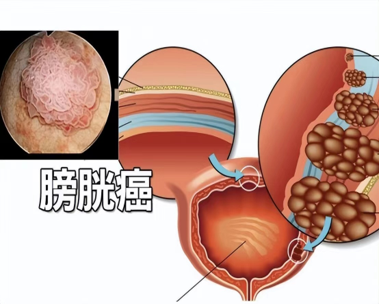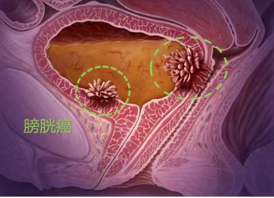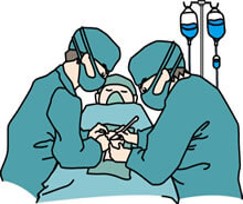

2024-05-17
Overview of Bladder Cancer
Bladder cancer refers to a malignant tumor that occurs on the bladder mucosa. It is the most common malignant tumor in the urinary system and one of the top ten common tumors in the body. It accounts for the first place in the incidence of urogenital tumors in China, and its incidence in the West is second only to prostate cancer, ranking second. In 2012, the incidence of bladder cancer in the national cancer registration area was 6.61/100,000, ranking ninth in the incidence of malignant tumors. Bladder cancer can occur at any age, even in children. Its incidence increases with age, and the high incidence age is 50-70 years old. The incidence of bladder cancer in men is 3-4 times that of women. In the past, the epithelium on the bladder mucosa was called transitional cells. In 1998, WHO and the International Urological Pathology Society jointly recommended the use of the term urothelial instead of transitional cells to distinguish it from transitional epithelium in the nasal cavity and ovaries, making urothelial a proprietary term for the urinary system. In the 2004 WHO “Pathology and Genetics of Urinary System and Male Reproductive Organs”, the histological classification of urinary system tumors includes bladder urothelial carcinoma, bladder squamous cell carcinoma, bladder adenocarcinoma, and other rare ones include bladder clear cell carcinoma, bladder small cell carcinoma, bladder-like carcinoma. The most common is bladder urothelial carcinoma, which accounts for more than 90% of the total number of bladder cancer patients. Usually, bladder cancer refers to bladder urothelial carcinoma, which was previously called bladder transitional cell carcinoma.

Causes of Bladder Cancer
The cause of bladder cancer is complex, with both inherent genetic factors and external environmental factors. The two most clear pathogenic risk factors are smoking and occupational exposure to aromatic amines. Smoking is currently the most certain risk factor for bladder cancer. 30%-50% of bladder cancer is caused by smoking. Smoking can increase the risk of bladder cancer by 2-6 times. As the smoking time prolongs, the incidence of bladder cancer also significantly increases. Another important pathogenic risk factor is related to a series of occupations or occupational exposures. It has been confirmed that aniline, diamino diphenyl, 2-naphthylamine, 1-naphthylamine are all carcinogens of bladder cancer. Long-term exposure to these chemicals increases the probability of bladder cancer. Occupational factors account for about 25% of the total number of bladder cancer patients. Occupations related to bladder cancer include aluminum products, coal tar, asphalt, dyes, rubber, coal gasification and other industries.

Clinical Manifestations
About 90% or more of bladder cancer patients initially present with hematuria, usually manifested as painless, intermittent, gross hematuria throughout the course, sometimes also as microscopic hematuria. Hematuria may only appear once or last for one day to several days, and it can alleviate or stop on its own. Sometimes the coincidence of the patient taking medicine and the cessation of hematuria often gives the patient the illusion of “cure”. Some patients may have hematuria again after a certain period of time. The color of hematuria varies from light red to dark brown, often dark red. Some patients describe it as meat washing water and tea water. The amount of bleeding and the length of hematuria are not necessarily proportional to the malignancy, size, range, and number of tumors. Sometimes when gross hematuria occurs, the tumor is already large or late; sometimes a small tumor can cause a large amount of hematuria. Some patients are found to have tumors in the bladder during health check-ups by B-ultrasound. 10% of bladder cancer patients may first present with bladder irritation symptoms, manifested as frequent urination, urgency, dysuria, and difficulty urinating, and the patient has no obvious gross hematuria. This is mostly due to tumor necrosis, ulceration, large or multiple tumors in the bladder, or diffuse infiltration of bladder tumors into the bladder wall, causing a decrease in bladder capacity or concurrent infection. Tumors in the bladder trigone and bladder neck can obstruct the bladder outlet and cause symptoms of difficulty urinating.
Clinical Diagnosis
Physical examination and past history Examine the body to determine whether the general signs of health are normal, including checking for disease markers, such as lumps or anything else that looks abnormal. The patient’s health habits, past diseases and treatment history are also part of the examination.
Internal examination For vaginal and/or rectal examination. The doctor will insert a gloved finger into the vagina and/or rectum to feel for any lumps.
Urinalysis Check the color of the urine and the substances in the urine, such as sugar, protein, red blood cells, and white blood cells.
Urine cytology examination Check the urine under a microscope to see if there are abnormal cells.
Cystoscopy Cystoscopy is inserted into the bladder through the urethra. The cystoscope is a thin tubular instrument with a light source and a mirror for observation. The cystoscope may also have tools for tissue sampling, and the tissue samples are then examined under a microscope for signs of cancer.
Intravenous pyelography (IVP) A series of X-ray examinations of the kidneys, ureters, and bladder to see if cancer is present in these organs. The contrast agent is injected into the vein, and when the contrast agent moves through the kidneys, ureters, and bladder, an X-ray examination is performed to see if there are any blockages.
Biopsy Remove part of the cells or tissues and have a pathologist look at them under a microscope to check for signs of cancer. The biopsy of bladder cancer is usually done during cystoscopy, and the entire tumor may be removed during the biopsy.
Clinical Suggestions
Surgical treatment (1) Transurethral resection (TUR) with electrocautery: A surgery that inserts a cystoscope (thin and light tube) into the bladder through the urethra. Then use a tool with a small wire loop to remove the tumor or use high-energy electric shock to burn the tumor. This is what is called electrocautery. (2) Partial cystectomy: A surgery to remove part of the bladder. This surgery is suitable for patients with low-grade cancer, and the tumor has invaded the bladder wall but is limited to part of the bladder. Because only part of the bladder is removed, the patient can urinate normally after the surgery. This is also called segmental cystectomy. (3) Radical cystectomy: A surgery to remove the bladder and any lymph nodes and nearby organs containing cancer cells. When bladder cancer invades the muscle wall, or when superficial cancer affects a large part of the bladder, this surgery can be performed. For men, the nearby organs to be removed are the prostate and seminal vesicles. For women, the uterus, ovaries, and part of the vagina will be removed. Sometimes, when the tumor has spread outside the bladder and cannot be completely removed, a surgery to remove only the bladder can be performed to reduce the urinary symptoms caused by cancer. When the bladder must be removed, the surgeon will create another way to urinate. (4) Urinary diversion: A surgery to create a new way for the body to store and excrete urine. Even if the doctor removes all the cancer cells visible during the surgery, there will still be patients who will undergo chemotherapy after the surgery to kill any possible remaining cancer cells. The treatment given after the surgery to reduce the risk of cancer recurrence is called adjuvant therapy.

Radiation therapy Radiation therapy is a type of cancer treatment that uses high-energy X-rays or other types of radiation to kill cancer cells or prevent them from growing. There are currently two types of radiation therapy. External radiation therapy uses a machine outside the body to radiate cancer. Internal radiation therapy uses radioactive substances sealed in needles, implanted particles, wires, or catheters, directly placed in and acting on cancer or near cancer. The way radiation therapy is given depends on the type and stage of the cancer being treated.
Chemotherapy Chemotherapy is a method of using drugs to stop the growth of cancer cells, either by killing the cells or by preventing the cells from dividing. When chemotherapy is given by mouth or by injection into a vein or muscle, the drug enters the bloodstream and reaches all the cancer cells in the body (systemic chemotherapy). When chemotherapy drugs are placed directly in the cerebrospinal fluid, an organ, or a body cavity such as the abdomen, the drugs will mainly affect the cancer cells in these areas (regional chemotherapy). For bladder cancer, regional chemotherapy will be performed inside the bladder (put into the bladder through a tube inserted into the urethra).
Biological therapy Biological therapy is a treatment method that uses the patient’s immune system to fight cancer. Use substances produced by the body or in the laboratory to promote, induce, or restore the body’s natural defense mechanism against cancer. This type of cancer treatment is also called biotherapy or immunotherapy. Treatment of bladder cancer can also use BCG (Bacillus Calmette-Guerin) intravesical biological therapy. Use a catheter (thin tube) to directly put the solution containing BCG into the bladder.
Living Care for Bladder Cancer
Psychological Care Patients with bladder cancer are prone to anxiety and panic, and they may struggle to accept the reality of urinary diversion. Healthcare providers should establish a good relationship with patients, actively communicate with patients and their families, and fully earn the trust of patients. They should explain the relevant knowledge of this disease in detail, inform patients of possible complications and adverse reactions, eliminate patients’ fear, anxiety, and even despair, and encourage patients to face the disease with a positive attitude and actively cooperate with treatment.
Disease Observation Before surgery, it is important to closely observe the patient’s hematuria. After surgery, closely monitor the patient’s vital signs, continuously monitor electrocardiography, observe and record changes in the patient’s pulse, heart rate, blood pressure, etc., and ensure the smoothness of the patient’s blood transfusion and fluid infusion. Observe the wound exudation situation and change dressings in time. Regularly monitor changes in the patient’s white blood cells and body temperature, and observe whether an infection occurs. Observe the color, nature, and volume of various drainage fluids. If a large amount of bright red fluid is drained in a short period of time, the doctor should be notified in time for treatment.
Dietary Care Before surgery, patients should be given high-protein, easily digestible, and highly nutritious food. For patients with difficulty eating, intravenous nutritional support should be provided to correct anemia and improve the patient’s overall nutritional status. After transurethral bladder tumor electroresection surgery, the patient can eat 6 hours later. The diet should be rich in nutrition and coarse fiber foods, and spicy and irritating foods should be avoided.
Drainage Tube Care Different labels should be attached to various drainage tubes for distinction. The drainage tube should be properly fixed to prevent it from falling out. Keep the drainage smooth and avoid bending. Observe and record changes in the nature, color, and volume of the drainage fluid.
Pre- and Post-Chemotherapy Care If the patient’s condition allows and there is an indication for radiotherapy and chemotherapy, radiotherapy and chemotherapy will be performed half a month after surgery. Patients who can hold urine after bladder preservation surgery will immediately undergo bladder perfusion chemotherapy. Before bladder perfusion, the urine should be emptied to prevent dilution of the chemotherapy drug. After perfusion, the patient is advised to drink more water and urinate frequently to excrete the chemotherapy drug remaining in the bladder.
Company Introduction:
Shenzhen SurgSci Medical Ltd., composed of clinical experts, industry veteran sales experts, high-level talents in Shenzhen, revolves around minimally invasive surgical ultrasound scalpels, electric staplers, surgical implant medical materials, etc., adheres to the product concept of import substitution and domestic breakthrough, and carries out technology research and development. In 2019, it received investment from Shenzhen Angel Mother Fund, and completed tens of millions of strategic financing in 2020. Since its establishment, it has jointly built a medical metal material laboratory, an acoustic laboratory, a precision instrument, and measurement laboratory, and a GMP sterile clean workshop with well-known domestic universities. It has a research and development team of more than 40 people. Since its establishment, it has applied for more than 60 patents at home and abroad, including more than 20 invention patents, 2 international invention patents, and more than 30 authorized patents. It has made major breakthroughs in fine-grained titanium alloys and high-performance piezoelectric ceramic materials, resolving the risk of foreign supply cuts. It will popularize minimally invasive medical technology, share high-quality humanistic care as its mission, base itself on clinical practice, unite with universities, benefit patients, give full play to the company’s engineering technology research and development strength, continuously explore the win-win mode of medical engineering production, education, research and application, make contributions to the national medical cause, and share minimally invasive medical technology with the world.
Product Introduction
Product Name: Disposable Ureteral Stent Kit

Scope of Application: This product is suitable for connecting the human renal pelvis and bladder, and for supporting and draining the human ureter.
Manufacturer: SurgSci Medical Ltd.
Send your inquiry directly to us